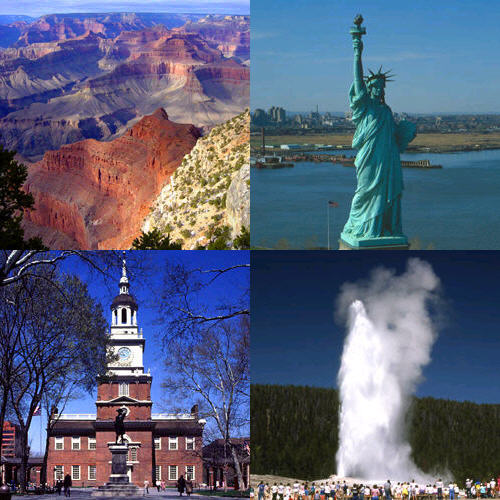World Heritage Sites

World Heritage Sites - Grand Canyon, Statue of Liberty, Yellowstone, Independence Hall - Photos from NPS.
What are World Heritage Sites?
World Heritage Sites are extremely exceptional cultural and natural properties nominated voluntarily by signatory nations, which have been approved for inclusion in the List by the World Heritage Committee. As of June 2008, there were 851 properties inscribed on the World Heritage List in 141 countries. These include 660 cultural sites, 166 natural sites and 25 mixed sites. It is not to be expected that World Heritage listing will ever be common. The criteria are exceptionally demanding.
What does the World Heritage Convention do?
The World Heritage Convention is intended to identify and help conserve natural and cultural sites of global significance. The World Heritage List is not intended to be simply an international compilation of national lists of significant sites, but rather a single global list of only those sites that possess “outstanding universal value.”
The World Heritage Committee’s Operational Guidelines state, “The Convention is not intended to ensure the protection of all properties of great interest, importance or value, but only for a select list of the most outstanding of these from an international viewpoint. It is not to be assumed that a property of national and/or regional importance will automatically be inscribed on the World Heritage List.” In practice, the international criteria for both nature and culture are subject to differences of interpretation and the application of principles of selection in strikingly different ways, but still they are, in their basic intent, highly selective, almost exclusionary.
The purpose of the World Heritage Convention (“Convention Concerning the Protection of the World Cultural and Natural Heritage”), the 1972 treaty which established the World Heritage List, is to enhance worldwide understanding and appreciation and international cooperation for heritage conservation and to recognize and preserve a relatively small number of exceptional natural and cultural properties around the world that have been formally determined to possess outstanding universal value to humanity. The United States, under President Nixon, was a primary architect of the World Heritage Convention and became the first signatory when the U.S. Senate ratified the treaty 95-0 on October 26, 1973. The United States has continuously maintained a leadership role in the work of the Convention, including serving multiple terms on the World Heritage Committee, the governing body of 21 countries elected from among the nations that have signed the Convention. In terms of nations, the World Heritage Convention, with 185 signatories, is the most nearly universal treaty for cultural preservation and nature conservation in human history.
What are the Selection Criteria?
In order to be included on the World Heritage List a site has to be of "outstanding universal value" and must meet at least one out of ten selection criteria. The original criteria included 6 cultural criteria and 4 natural criteria. In 2005 the criteria were combined into one set of 10 criteria and the natural criteria were renumbered.
Criteria I - Cultural Criteria I: Represent a masterpiece of human creative genius;
Criteria III - Cultural Criteria III: Bear a unique or at least exceptional testimony to a cultural tradition or to a civilization which is living or which has disappeared;
Criteria IV - Cultural Criteria IV: Be an outstanding example of a type of building, architectural or technical ensemble or landscape which illustrates (a) significant stage(s) in human history;
Criteria V - Cultural Criteria V: Be an outstanding example of a traditional human settlement, land-use or sea-use which is representative of a culture (or cultures) or human interaction with the environment, especially when it has become vulnerable under the impact of irreversible change;
Criteria VI - Cultural Criteria VI: Be directly or tangibly associated with events or living traditions, with ideas, or with beliefs, with artistic and literary works of outstanding universal significance (preferably used in conjunction with other criteria);
Criteria VII - Natural Criteria I: to contain superlative natural phenomena or areas of exceptional natural beauty and aesthetic importance;
Criteria VIII - Natural Criteria II: to be outstanding examples representing major stages of earth's history, including the record of life, significant on-going geological processes in the development of landforms, or significant geomorphic or physiographic features;
Criteria IX - Natural Criteria III: to be outstanding examples representing significant on-going ecological and biological processes in the evolution and development of terrestrial, fresh water, coastal and marine ecosystems and communities of plants and animals;
Criteria X - Natural Criteria IV: to contain the most important and significant natural habitats for in-situ conservation of biological diversity, including those containing threatened species of outstanding universal value from the point of view of science or conservation;
The management, integrity, protection and authenticity of sites are also important considerations. A site can be delisted due to failing to meet these considerations.



